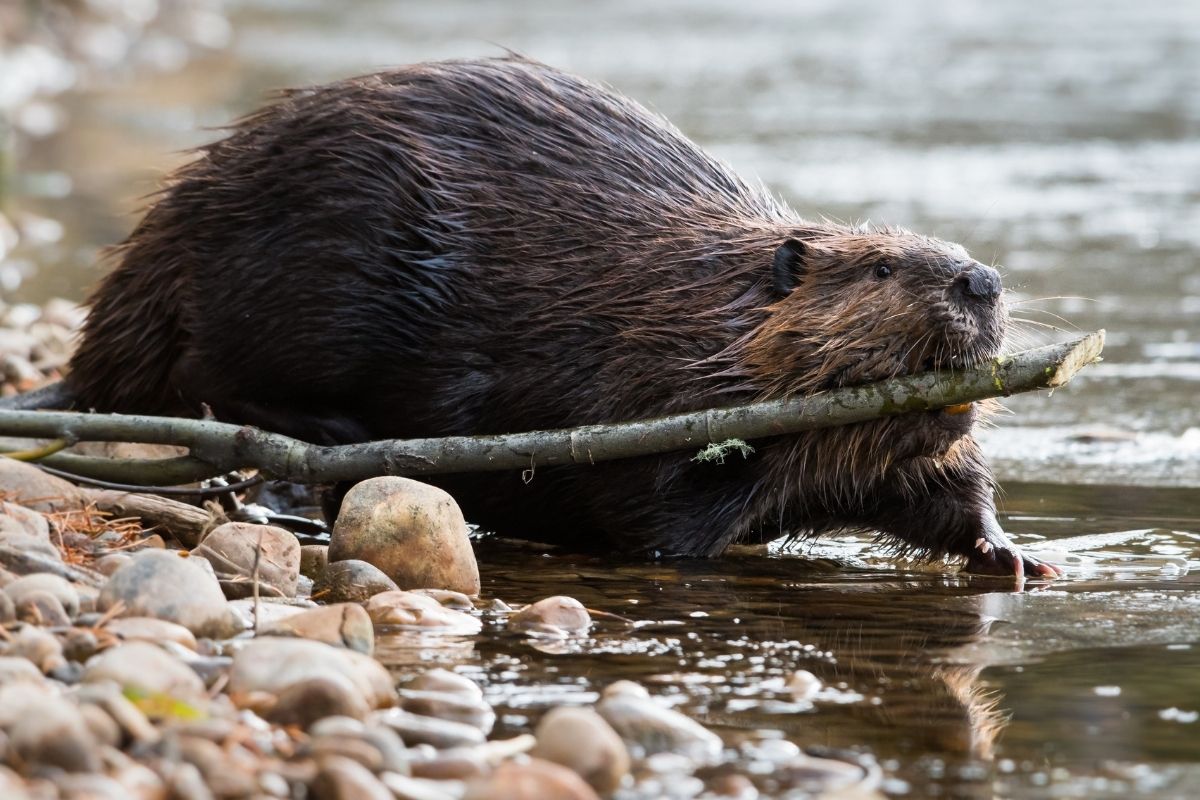by Scott Smith, Communications Director
Everybody knows the beaver for its tireless efforts to construct massive homes of chewed-up branches and plants and mud in its aquatic environment. Its reputation as nature’s most industrious ecosystem engineer is well earned. So, too, is its role as a keystone species, for the log dwellings beaver build in streams and slow-moving waters boost wildlife up and down the food chain, fostering biodiversity and improving habitat like no other animal.
North America’s largest rodent, Castor canadensis can weigh more than 70 pounds, reaching nearly four feet long from thick wide tail to chisel-shaped incisors. Those teeth grow continuously as the busy beaver gnaws its way through tree trunks up to a foot thick to eat bark and drag the branches back to its watery lair – sometimes as much as 200 yards away.
The dams beavers build alter the paths of streams and rivers, creating extensive habitats far beyond their reach. Here are just some of the ways other plants and animals benefit:
- Beavers help waterfowl by creating increased areas of water. In a study of Wyoming streams and rivers, watercourses with beavers had 75 times as many ducks as those without.
- The widening of the riparian zone associated with beaver dams has been shown to increase the abundance and diversity of birds favoring riverbanks, an impact that may be especially important in semi-arid climates.
- As trees are drowned by rising beaver impoundments, they become ideal nesting sites for woodpeckers, which carve cavities that attract many other bird species.
- The presence of beavers can increase wild salmon and trout populations, and the average size of these fish.
- The slow-moving and standing waters of beaver ponds also provide ideal habitat for freshwater turtles, frogs and other water-dependent species like dragonflies, mussels and snails.
- Other semi-aquatic mammals, such as muskrats, minks and otters, use beaver lodges.
- Large herbivores like deer, moose and elk benefit from beaver activity as they can access vegetation from fallen trees and ponds; beavers themselves are preyed upon by wolves, mountain lions and bears.
When settlers arrived on American shores, there were as many as 400 million beavers, or up 75 per square mile, nearly coast to coast. In spite of being plundered by the fur trade, in recent decades beavers have staged a remarkable comeback, reclaiming and restoring habitats and improving biodiversity from river bottom to mountain meadow. And even better news: Only now are the scientists who study the North American beaver realizing just how important the species is in helping offset the ever-growing impacts of the climate crisis.
New research from the Natural Resources Research Institute at the University of Minnesota Duluth has conclusively demonstrated that beavers are essential for freshwater conservation and ecosystem stability. The study suggests beavers can be a biological tool that helps buffer ecosystems against disturbances and alterations.
In the Chesapeake Bay region, where beavers had been missing for hundreds of years, a group of “beaver believers” are campaigning to allow beavers to replumb the stream systems, which they contend will sharply reduce Bay pollution at a fraction of anticipated costs while increasing the diversity and productivity of streams for frogs, birds and fish.
Ecotone, an ecological restoration company, claims “stream systems that include beaver-engineered ponds will also buffer the impacts of climate change by reducing downstream flooding, mitigating drought and recharging groundwater,” reports the Bay Journal.
Out West, the resurgent beaver populations are being lauded for creating refuges for wildlife fleeing wildfires. “Along with deterring the flames themselves, beaver dams and ponds also function as filters for ash and other fire-produced pollutants that enter waterways—thus maintaining water quality for fish, other aquatic animals, and humans,” writes Isobel Whitcomb for Scientific American.
Yet more research shows that sediment trapped behind beaver dams, even those constructed centuries ago, store large amounts of carbon.
Don’t blame the beavers
As beavers recolonize heritage territories and get on with their busy work, they are finding, of course, that they are no longer the only engineer around. “In the densely developed eastern U.S., where I work, it’s hard to find open areas where beaver ponds can spread out without flooding ditches or roads. Beavers also topple expensive landscaped trees and will feed on some cultivated crops,” says Christine E. Hatch, Professor of Geosciences at UMass Amherst.
“Beavers are frequently blamed for flooding in developed areas, even though the real problem often is road design, not beaver dams,” writes Hatch in The Conversation, an online journal published by UMass Amherst. In such cases, removing the beavers doesn’t solve the problem, she adds.
The U.S. population of North American beaver (they have a Eurasian cousin) now stands at 10 to 15 million. However, trapping and killing beavers remain commonplace. Last year, the Department of Agriculture’s Wildlife Services’ branch killed 23,000 “nuisance” beavers. And while 10 states have banned trapping wild animals as inhumane, the practice is widespread elsewhere. In Minnesota, for example, trappers have killed 20,000 to 30,000 beavers annually in recent years.
Rather than trapping and killing beavers, ecologists advocate solutions that “out engineer” the beavers. Strategic fencing and hardwire cloth can protect trees and shrubs from beaver damage. Flow devices and so-called beaver pipes are used to manage beaver flooding. For example, the Beaver Deceiver is a semi-submerged boxed wire fence that has proven effective in discouraging beavers from building dams that obstruct culvert pipes that run under bridges. To the beaver a culvert seems like just the thing that needs to be plugged, but such blockages can cause major damage to bridges and the roadway on either side.
Says beaver expert Hatch: “I believe we can learn from beavers’ water management skills, coexist with them in our landscapes and incorporate their natural engineering in response to weather and precipitation patterns disrupted by climate change.”

